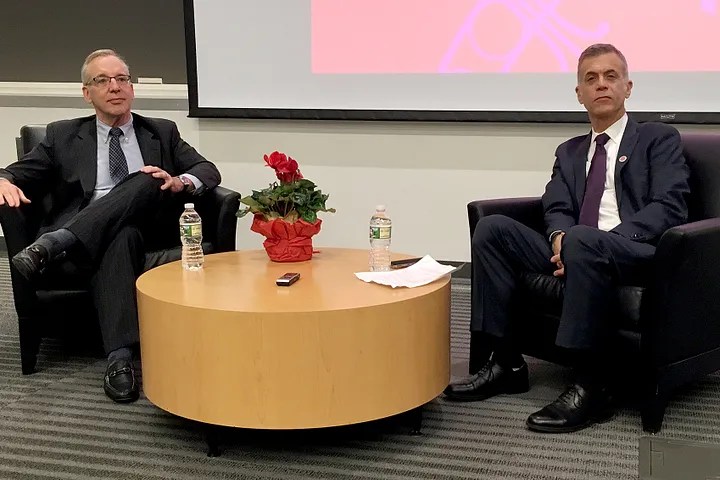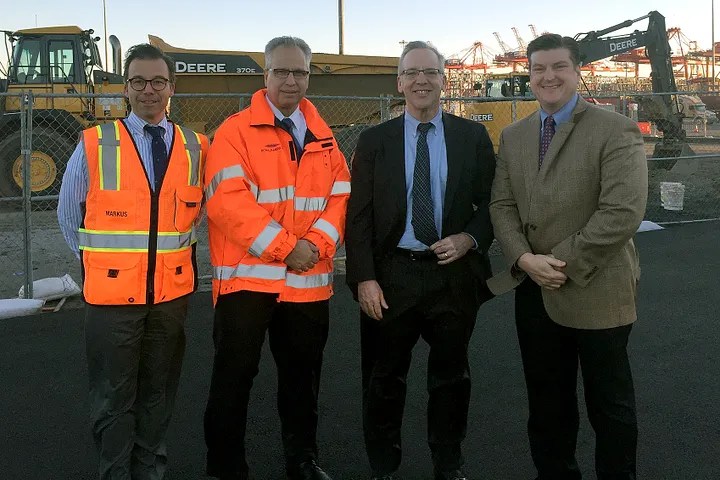
Photo: Riya Prabhudesai/Rutgers University
On our fourth and final regional visit of 2017, we learned about key issues facing Northern New Jersey and efforts underway to promote inclusive economic growth. The local business and community leaders we spoke with in New Brunswick, Kearny, and Newark raised issues of affordability and mobility, discussed efforts to link local residents to local jobs, and highlighted efforts to repurpose and adapt land and buildings for the 21st century economy.
Affordability and Mobility
In a fireside chat at Rutgers University in New Brunswick, professor Eugene White questioned why economic growth in New Jersey consistently lags the national average. New York Fed President Bill Dudley explained that when workers leave a region in search of a lower cost of living and greater levels of economic mobility, that can act as a drag on the local economy.
“I think that’s part of a much broader story, which is the migration of people from the Northeast and Midwest to the South and West that’s been going on for 30 years. Population growth in New Jersey is well below the national average, and that’s really probably the primary driver of the fact that the growth rate in New Jersey is going to be a little bit weaker than the country as a whole,” he said.
Throughout our meetings in Northern New Jersey, we heard often about issues related to affordability — especially when it comes to housing. Leaders from New Jersey Community Capital (NJCC) explained that New Jersey has among the highest housing costs in the nation, along with a foreclosure backlog that is about twice the U.S. average. Taken together, these issues make for a challenging local housing market. Through its Community Asset Preservation Corporation (CAPC), NJCC acquires pools of foreclosed properties, rehabilitates these homes, and makes them available as affordable housing. Since 2009, NJCC has acquired 600 homes and, in partnership with local stakeholders, returned them to the stock of affordable housing.
We heard more about issues of affordability in a discussion with the leaders of the United Way’s ALICE Project, which documents the gap between basic living expenses and income that exists for many New Jersey residents.
United Way uses ALICE — an acronym for Asset Limited, Income Constrained, and Employed — to describe households within New Jersey that have an income above the federal poverty level, but cannot afford basic living necessities such as housing, childcare, food, transportation, and healthcare. Members of such households are often employed as home health aides or laborers — jobs that are not likely to be eliminated by technological advancements, and that actually are likely to increase in number given demographic trends.
Dr. Stephanie Hoopes, who leads the research project, pointed out that even when accounting for all income and resources for ALICE and poverty-level households — including government and nonprofit assistance — there is still a shortfall between what these households bring in and what they need to pay their bills. Assistance is not evenly distributed across budget areas, with especially large gaps in housing and childcare — which, incidentally, are the largest components of a household budget.
A study by the United Way shows that just over a third of New Jersey residents cannot afford basic necessities. Not surprisingly, one of the most common types of ALICE households is a family with children. In northern New Jersey, more than 40% of the households in Essex, Hudson, and Passaic counties are counted as ALICE, while about a third of households in Bergen, Middlesex, Monmouth, and Sussex counties qualify.
Increasing Local Employment in Newark
In Newark, we learned more about the outlook for local employment. Over lunch, Mayor Ras J. Baraka explained that while Newark is home to many companies, they employ relatively few of the city’s residents in the aggregate. He said that business leaders were surprised to learn about the disparity, and his administration is engaging with corporate partners to address the issue.
Newark 2020, a partnership between local government and the private and nonprofit sectors, aims to land local jobs for 2,020 unemployed residents by the year 2020. The goal is to ensure that as Newark prospers, its residents do too.
The city also uses the tax code to promote local employment. Last year, the local government approved a payroll tax cut for businesses that can show that local residents account for more than half of their employees. And, efforts to expand the procurement pipeline to include small and medium-size firms based in Newark is expected to result in increased local hiring.
The importance of capabilities relative to credentials surfaced as an issue during the discussion. The question is whether there should be a focus on educational credentials for certain jobs, when there may be many capable Newark residents with less education who could succeed if given the opportunity. If firms would reconsider education requirements for some roles, they might have a broader pool of potential candidates from which to choose.
A Budding Small Business Hub
At another stop, we got a firsthand look at adaptive reuse, or the transformation of old sites or buildings for new purposes. Kearny Point is a former shipyard that now is a growing hub for small and midsize businesses. While the shipbuilding days of the site are long past, owner Hugo Neu Corporation is repurposing the property for various functions, with the first stage focused on office space for small companies, including a number of tech firms. While the developer has had early success finding tenants, we learned that one challenge is that the depth of demand for space among smaller to midsize firms is unclear.
Looking beyond office space, the site has the potential to attract members of the broader community as a destination for recreational activities and entertainment. Kearny Point is situated between Newark and Jersey City, meaning Newark Airport, the Port of Newark-Elizabeth, Hoboken, and the Holland Tunnel are nearby. Its waterfront location means ferry service may be possible in the future, and the group leading the redevelopment explained how environmental considerations have been factored into plans for the site. After Hurricane Sandy battered the area, development plans include fortifying elements to prevent flooding and make it resilient to future storms.
Port Transformation

We also learned about land use challenges at the Port Newark Container Terminal, where we saw firsthand how hundreds of millions of dollars of investment are being used to expand operations at the sprawling site and make them more efficient.
Despite the sheer size of the terminal, its footprint remains relatively fixed, so one challenge the operator faces is how to make the best use of the space. To that end, some of the recent investment has gone toward raising the roadway of the Bayonne Bridge and the renovation of ship berths to allow larger ships to dock.
Further, reorganized storage yards and new cranes and gantries have allowed for higher stacking of containers. We learned of a streamlined approach to handling truck traffic, as well as improvements to water access and the area rail network, while a number of processes have been automated to make operations more efficient.
Our next regional visit will be to Puerto Rico and the U.S. Virgin Islands. For more about the purpose of the New York Fed’s regional visits and what we heard on earlier trips this year, see our posts on Queens, the North Country region, and Syracuse, Ithaca, and Rochester.
This article was originally published by the New York Fed on Medium.
The views expressed in this article are those of the contributing authors and do not necessarily reflect the position of the New York Fed or the Federal Reserve System.










